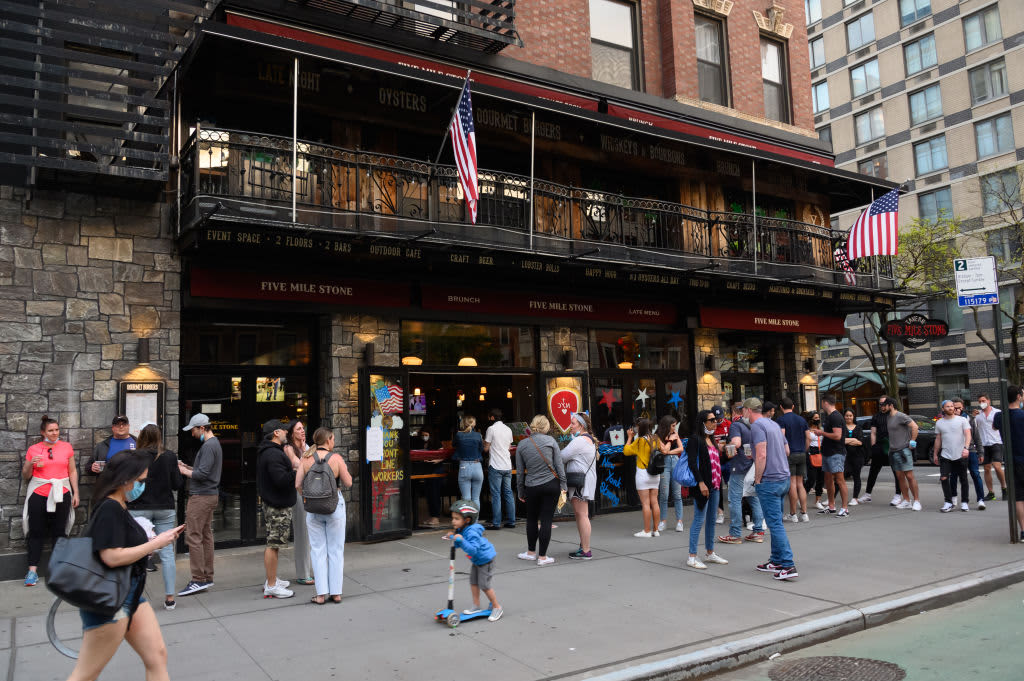Products You May Like
People congregate outside a restaurant in the upper east side during the coronavirus pandemic on May 2, 2020 in New York City.
Noam Galai | Getty Images
As states gradually reopen, the U.S. economy is showing signs of life after one of the most significant downturns in history.
Though many restrictions remain in place across the country, Americans are gaining a greater sense of normalcy as they venture out to restaurants, increase travel and buy new homes.
These charts track five key indicators that signal a growing revival of the economy as consumers resume familiar routines and move forward from lockdown measures and business closures.
Americans are starting to drive and walk again, though transit use is lagging
Apple Maps is often a go-to navigation app for many travelers. However, with stay-at-home orders implemented throughout the majority of the U.S. in March and April, many Americans could only venture out for essential reasons, such as a trip to the grocery store. Data from Apple shows a sharp decline in requests for directions on Apple Maps during the early stages of pandemic as lockdown measures were put in place.
As states began to ease travel restrictions, data shows an increase in requests for walking and driving directions. With retailers, beaches, parks and other places reopening, travelers have had more places to visit these past few weeks.
However, requests for transit directions still remain at less than half of their previous levels. As employees continue to work from home and travelers remain fearful of catching the virus in crowded subway cars, buses and trains, public transportation may not be an ideal option yet for many commuters.
Diners are returning to restaurants
The restaurant industry was hit hard by the coronavirus as most states restricted their business to takeout, delivery and curbside pickup. Data from the OpenTable network shows that restaurant bookings plummeted as these regulations were put in place, and were down 100% in the last weeks of March and most of April when compared to last year.
However, several states have allowed restaurants to reopen dining and there was a recent uptick in bookings in May, indicating that the worst of the pandemic could be over for the food service industry. These restaurants are often required to operate under new health guidelines such as capacity limitations and having to space tables six feet apart.
Hotel occupancy rates are coming back
The pandemic dealt a serious blow to the hotel industry and the broader travel sector, as restrictions were put in place both within the U.S. and abroad. During the initial stages of the outbreak, global hospitality research company STR reported that the occupancy rate for U.S. hotels was at just over 20% in April, a steep drop from their more than 60% occupancy in February. The pandemic also prompted major hotel chains and resorts to temporarily close properties as travelers put their plans on hold.
However, occupancy rates began to increase in April and May as people resumed travel for business and leisure, and more hotels reopened. To help keep guests safe, major hotels have enhanced their cleaning procedures and put new health protocol in place, such as requiring employees to wear masks and putting plexiglass barriers at the front desk.
Air travel is picking up, but still down significantly
With airlines clamoring for government bailouts to stay afloat, the air travel industry has been one of the most visible parts of the economy impacted by the coronavirus. The daily number of travelers passing through Transportation Security Administration checkpoints fell almost 100% year-over-year in March and April and has picked up only slightly in May, according to data from TSA screenings.
However, as travel has increased, airlines have had to adjust booking policies in order to ease customers’ fears of contracting the coronavirus. Companies like American Airlines and United Airlines are alerting passengers when planes are full and are making it easier for them to switch flights.
Home purchases are up vs. last year
As coronavirus-related restrictions ease, potential homebuyers have been able to tour open houses and resume their search for a new home. Though the singly-family home mortgage purchase index saw a more than 30% drop in April when compared to last year, it has since reversed its course, according to data from the Mortgage Bankers Association. The index is now up almost 10% compared to the same period last year, indicating that the home purchase market could be on its way to a quick recovery.

